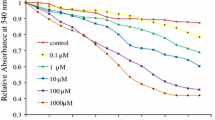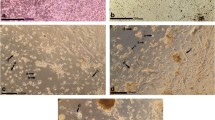Abstract.
To examine the demethylation reaction of methylmercury (MeHg) in rat liver, slices prepared from MeHg-treated rats were incubated in L-15 medium under 95% O2/5% CO2 atmosphere. During the incubation, the amount of inorganic Hg in the slices markedly increased in a time-dependent manner, although the concentration of total Hg remained unchanged. Since the C-Hg bond in MeHg was demonstrated to be cleaved by the action of some reactive oxygen species, the effects on MeHg demethylation of several reagents that could modify reactive oxygen production were examined in the present system. Methylviologen was found to be an effective enhancer of the demethylation reaction with only a minor effect on lipid peroxidation. On the other hand, ferrous ion added to the medium showed no effect on demethylation in the presence or absence of methylviologen, although lipid peroxide levels were increased significantly by ferrous ion. Similarly, deferoxamine mesylate, which effectively suppressed the increase in lipid peroxide levels, also had no effect on demethylation. Furthermore, hydroxy radical scavengers, such as mannitol and dimethylsulfoxide, had no effect on inorganic Hg production. Rotenone, an inhibitor of complex I in the mitochondrial electron transport system, increased levels of both inorganic Hg and lipid peroxide. However, other inhibitors, such as antimycin A, myxothiazole and NaCN, significantly suppressed the demethylation reaction. Cell fractionation of the MeHg-treated rat liver revealed that the ratio of inorganic Hg to total Hg was highest in the mitochondrial fraction. Furthermore, superoxide anion could degrade MeHg in an organic solvent but not in water. These results suggested that the demethylation of MeHg by the liver slice would proceed with the aid of superoxide anion produced in the electron transfer system at the hydrophobic mitochondrial inner membrane. Furthermore, the involvement of hydroxy radicals, which have been demonstrated to be effective in cleaving the C-Hg bond in the aqueous media, might be minimal. Here, we also demonstrated that liver slices are a useful experimental model for mimicking the MeHg biotransformation reaction.
Similar content being viewed by others
Author information
Authors and Affiliations
Additional information
Electronic Publication
Rights and permissions
About this article
Cite this article
Yasutake, .A., Hirayama, .K. Evaluation of methylmercury biotransformation using rat liver slices. Arch Toxicol 75, 400–406 (2001). https://doi.org/10.1007/s002040100256
Received:
Accepted:
Issue Date:
DOI: https://doi.org/10.1007/s002040100256




